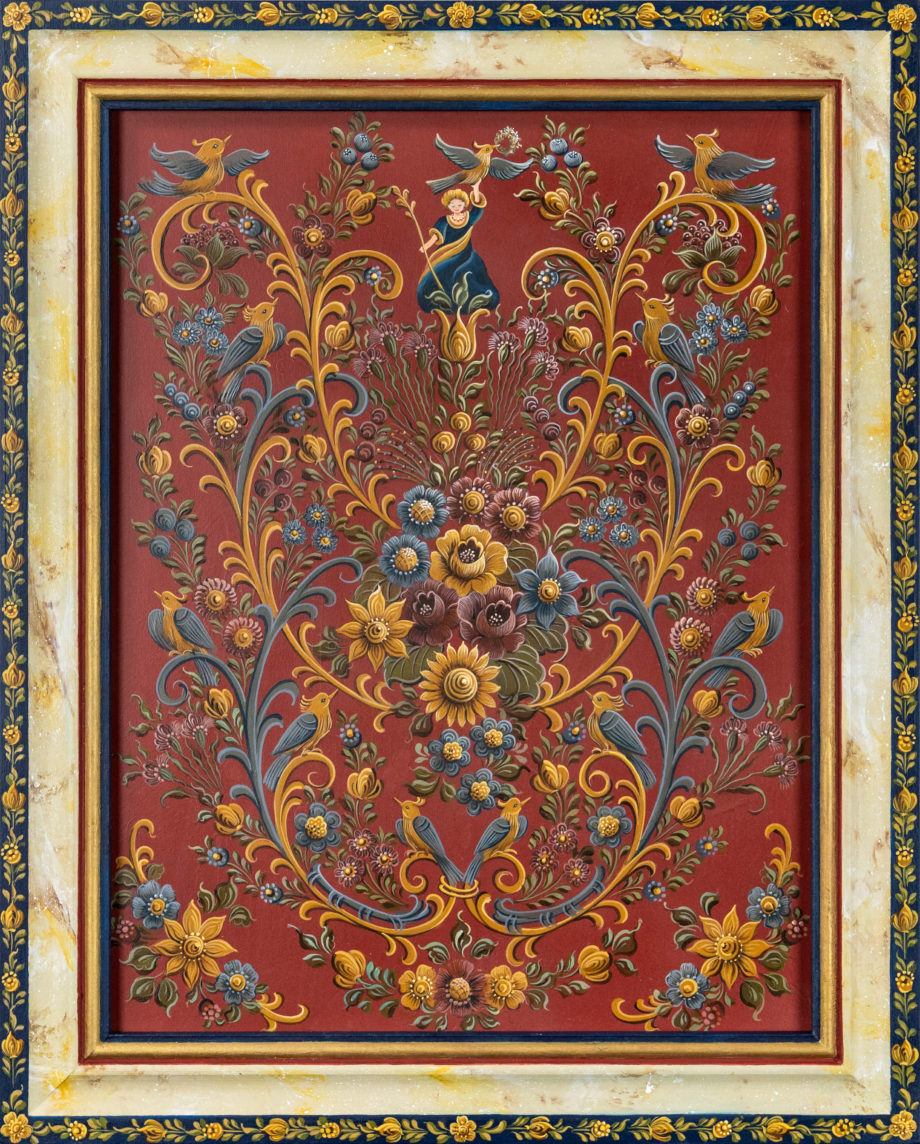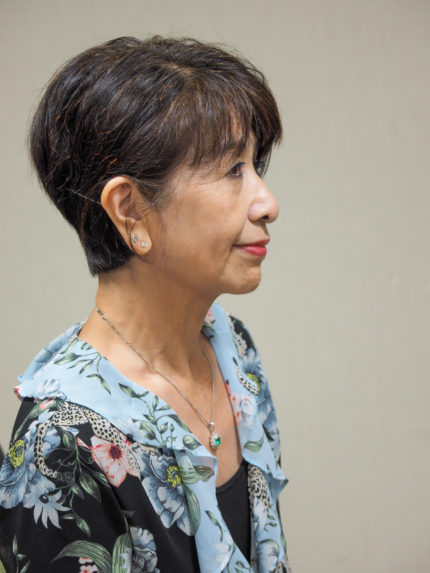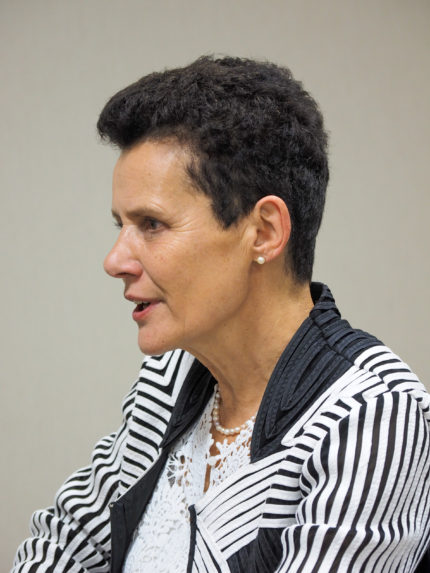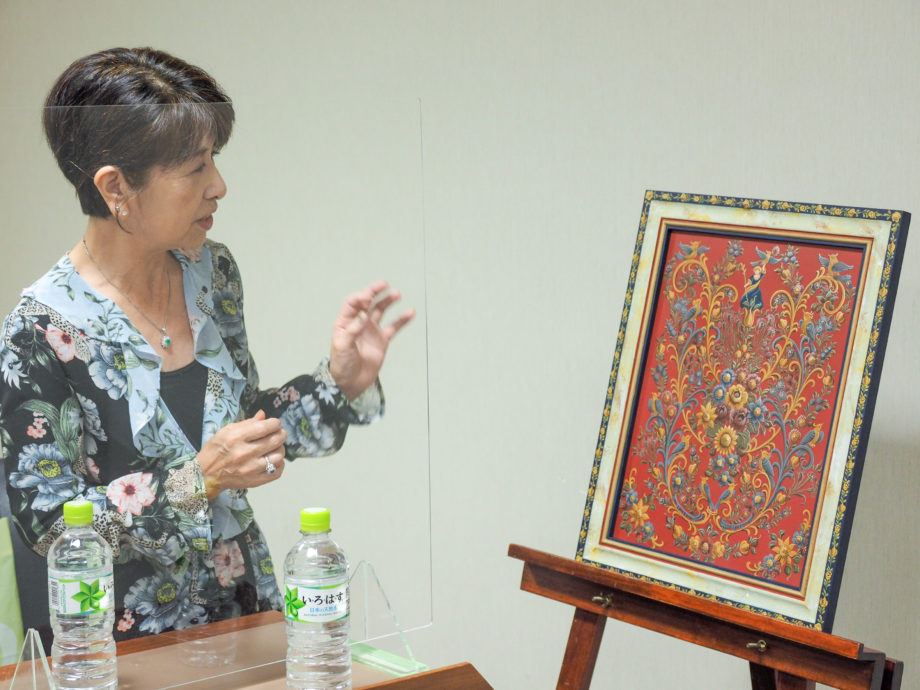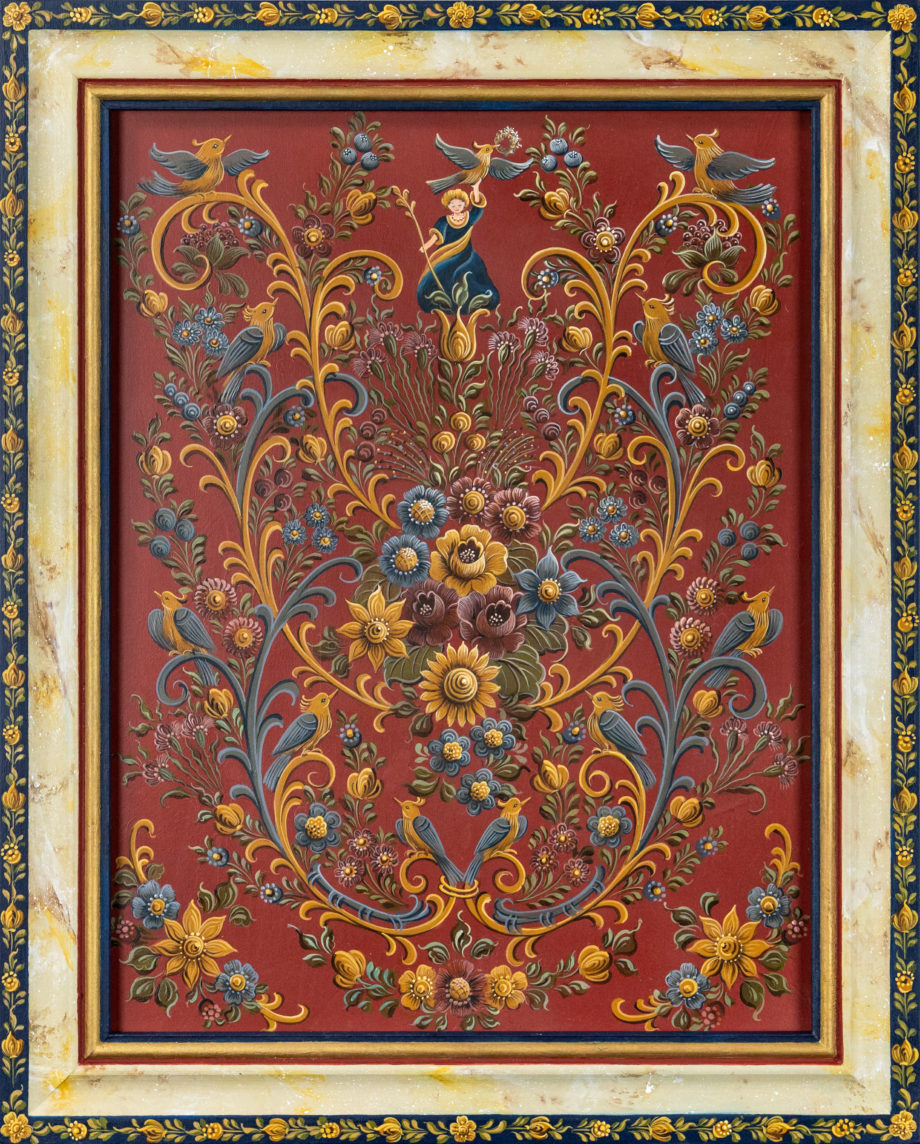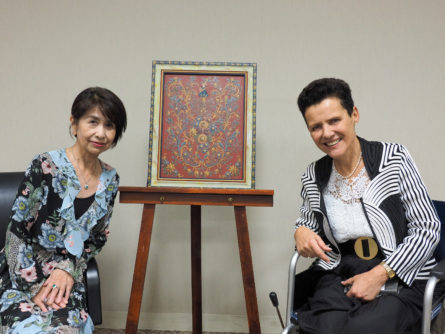- JEPAA Member
- European Folk Art
- Etsuko Hosaka
- ヨーロピアンフォークアート
- 保坂悦子
© 2024 Etsuko Hosaka.
SCROLL
Portfolio /作品一覧
- 希望と平和~祈りの花園~(オランダ フローラルアート) Hope and Peace~Prayer Garden~(Floral Art, Holland)
- 平和の女神に祈りを込めて/Praying to the Goddess of Peace
Interview article /対談記事
時代も国境も越えるヨーロピアンフォークアートの伝道師
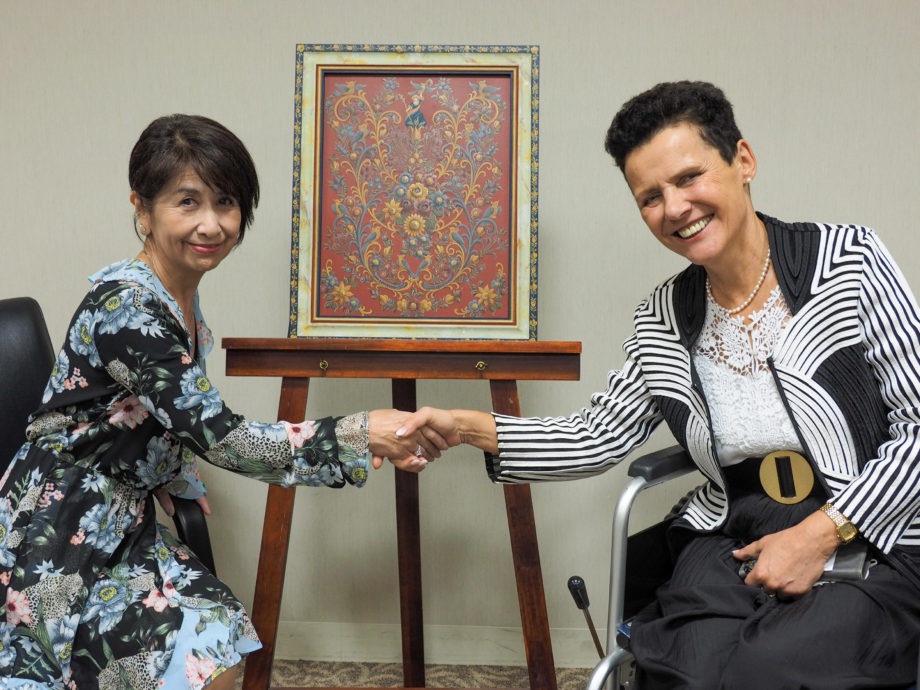
カトリン=スザンネ・シュミット(以下 シュミット):保坂先生はヨーロピアンフォークアートを日本で実践される数少ない芸術家と伺いました。私はドイツのベルリンに住んでいますが、ヨーロピアンフォークアートという芸術技法については、まったく知りませんでした。ですから、保坂先生の芸術家としての半生をお聞きしながら、このヨーロピアンフォークアートについても学んでいきたいと思います。どうぞよろしくお願いします。
保坂悦子(以下 保坂):こちらこそよろしくお願いします。私は 30 年ほど前からヨーロッパスタイルのアートを勉強し始めました。現在は地元の三重県で制作活動をしています。ヨーロッパの国々の、民芸絵画をいろいろな先生から学んできました。中でもヨーロピアンフォークアートは、私の師事した先生がオランダのヒンデローペン(オランダ北部のアイセル湖に面した漁師の町。町名を冠した木工芸などが現在に受け継がれている。静かな運河の畔の街並みはメルヘンの世界観のように美しい。)という街で学んで来られたと聞いています。
シュミット:私は初めて先生の作品を見た時に祖母の家に同じようなものが飾ってあったのを思い出しました。思いがけず昔の記憶と出会って驚いたことをよく覚えています。
保坂:ヨーロピアンフォークアートは一度衰退してしまって、時間が経って再評価されるようになったんです。もしかしたらシュミットさんのお祖母様の家にあったものは、その忘れられた時代のものかもしれませんね。
シュミット:そうなのかもしれません。ただし祖母が持っていたものはあまり精巧に描かれた作品ではありませんでした。やはり保坂先生の作品は芸術であり、祖母の持ち物は日用品だったのだと思います。ところで先ほどのお話ですと、最初にヨーロピアンフォークアートを日本で広められたのは保坂先生の師事した芸術家の方々で、その貴重な教えを現在に守り継承されていらっしゃるのが保坂先生ということになるでしょうか。
保坂:はい、そうですね。日本の方は手先が器用な方が多いので一時期ブームになって現在ではだいぶ広まっています。
シュミット:今回池袋展にご出展くださった作品も素晴らしいですね。描かれている鳥も美しいですが、これは鳩でしょうか?
保坂:これはラッキーバードという鳥のモチーフです。これはおそらくですが、オランダと貿易が盛んだった頃そういう時代にいろんな文化を持って帰っていったと思うんです。当時インド神話に出てくる神鳥ガルーダ(インド神話に登場する炎の様に光り輝き熱を発する神鳥。ヒンドゥー教徒の多い東南アジアでは、馴染み深い神様として様々な文化・文学のモチーフとして引用される)をモチーフに描かれたものもあったくらいでしたから。こういった物がどうして出てきたかというと、オランダが衰退して物がなくなった時に彫刻に見えるように家具に描かれたのが始まりと言われています。
シュミット:ヨーロピアンフォークアートについて、よろしければもう少し詳しく教えていただけないでしょうか。
保坂:実はヨーロピアンフォークアートって、私の先生がヒンデローペンで習った技法の他にも、様々なスタイルがあるんですよ。シュミットさんのご実家にあったのはフローラルペインティングというスタイルで描かれた作品ではないかと思うのですが、むしろ私が最初に学んだのはこのフローラルペインティングだったんですよ。色々な技法を総括して、ヨーロピアンフォークアートと呼んでいます。
シュミット:そうだったんですね。奥が深いです。改めてこちらのヒンデローペンの作品についてお伺いしますが、こちらは何をテーマにして描かれましたか。
保坂:この作品は平和をテーマとして描きました。ラッキーバードを多く描いて、幸福を描きたかったんです。
シュミット:平和は、今もっとも重要なテーマですね。ここ数年で世界はまったく変わってしまったように思われます。ドイツは他の国と比べれば落ち着いていますが、それでも脅威を身近に感じるようになりました。
保坂:そうなのですね。私も昨今の世界情勢を見聞きしていると、心が痛みます。このような状況は、一刻も早く終わってほしいですね。
シュミット:まったくそのとおりですね。ただ嘆いていても仕方がないので、自分にできることをしていきたいと思っています。今回のことで改めて感じましたが、安定した社会というのは非常に重要だということです。芸術はそれを伝える力があるので保坂先生が描くテーマは非常に重要だと感じています。
保坂:そうですね。私もこの作品では、平和を象徴するものを意識して描き入れています。上部には平和の女神が描かれていまして、蔓でハートを描いています。私の心が届きますようにという願いを込めてこのような形になっています。よく見ていただくといくつかのハートが絵の中に隠れていますが、これは気づく人が気づいてくれたらと思ってこっそり描き込みました。
シュミット:確かにいくつものハートが浮かんできました。すぐには気づかないというのが面白いですね。道具を使い続ける中でだんだんと気づいていくのだと思いますが、もし見つけられたら、ますます道具に愛情を持ってくれるのではないでしょうか。
保坂:またたくさんの花を描いていますが、そこには平和な時代になってお花がたくさん咲くように、その周りを鳥が飛び交うようなそんな時代になってほしいという願いを込めています。
シュミット:平和のモチーフが数多く描かれているんですね。とても気持ちが伝わる作品です。素晴らしい。しかし先生がヨーロピアンフォークアートを初めた際にあまり日本では広まっていなかったとお伺い致しました。芸術家として活躍するまでには、かなりのご苦労があったのではありませんか?
保坂:そうですね、多くの表現を習得するために多くの先生から技法を教えて頂いたんですが、その方々の意図を汲み取っていくためにかなり試行錯誤しました。ただそれが土台となって今があると感謝をしております。また、母の介護があったのでその中で制作をしていくのは大変でしたね。
シュミット:そんな状況でも続けていたというのは好きだったからということですよね。
保坂:その通りですね。描きたいものがたくさんあったのでそれに救われたことも多くありました。
シュミット:なるほど、ある意味で芸術は薬みたいですね。見た人も作る人も芸術が活力となってそれが生きる力になるような。それがこういった文化交流の場で伝わることが非常に嬉しく思います。正直先生の作品からヒンデローペンを知りましたが、このように文化間を超えて伝えていらっしゃる方がいるのは素敵ですね。これからしっかりヨーロピアンフォークアートを伝えることをしていきたいと思います。
保坂:嬉しいです。よろしくお願い致します。
シュミット:そして何よりも自分の描きたいものを描き、自身の納得する表現で描くことは何よりも大切です。
保坂:この戦争やコロナのことがあってなんでもない些細な日常が大切だということを痛感いたしました。だからこそその当たり前にあるものに感謝の気持ちを持つ意味を作品を通して伝えていきたいと感じています。また私は生徒さんを持っているので、その方々にも伝えていきたいです。
シュミット:そうですね。日常に感謝するというのは当たり前のようでなかなかできることではないので、私もその気持ちを大切にしていきたいです。その上で先生がこれからしていきたいことはありますか。
保坂:ヨーロピアンフォークアートは一つ一つの技法に守らなければいけない決まり事がありますが、それを順守しつつ自由な表現をしていきたいと考えています。そして何より気持ちが伝わる作品を描いていきたいです。自分達の力はちっぽけですが、その気持ちだけは持って制作をしていきたいです。またヨーロピアンフォークアートは家具に描かれることが多いのですがファニチャーアートにも力を入れていきたいですね。
シュミット:保坂先生の向上心、また平和を愛する気持ちは素晴らしいと思います。ぜひこれからヨーロピアンフォークアートがますます普及していくこと、先生の平和の祈りをみんなが共有できることを私も願っています。
(2022年特別対談 保坂悦子×カトリン=スザンネ・シュミット)
Evangelist of European Folk Art Who Transcends Time and National Borders
Katrin-Susanne Schmidt: I heard that you’re one of the few artists who make European folk art in Japan. I live in Berlin, Germany, but I had no idea about the art technique European Folk Art. Therefore, I would like to learn more about this European Folk Art while hearing about the life of Mr Hosaka as an artist. Please do let me know.
Etsuko Hosaka: My pleasure to meet you too.I started studying European-style art about 30 years ago. I am currently working in my home prefecture of MIE. I have studied folk art painting in European countries from various teachers. I’ve been told that the teacher who taught me came to study European folk art in a town called Hindeloopen (Fishermen’s town on Lake Ijssel in the north of the Netherlands. Wooden crafts,such as those named after the town, have been handed down to the present day. The town’s quiet canal-side streets are as beautiful as in a fairy tale.) in the Netherlands.
Schmidt: When I saw your work for the first time, I recalled that my grandmother had something similar displayed in her house. I clearly remember being surprised when I unexpectedly came across that old memory.
Hosaka: European folk art declined once, but it came to be reevaluated over time. Perhaps, the piece at your grandmother’s house is from that forgotten era.
Schmidt: It may well be so. However, my grandmother’s items were not very elaborately painted works of art. After all, Ms Hosaka’s work was art, while my grandmother’s items were daily necessities. By the way, based on what you said earlier, The first European folk art artists to promote European folk art in Japan were those who studied under you, and you are preserving and passing on their valuable teachings to the present day?
Hosaka: Yes, that’s right. Many Japanese people are dexterous with their hands, so it became popular for a while and is now widespread.
Schmidt: The work you exhibited at the Ikebukuro exhibition this time is also wonderful. The birds were painted beautifully. Are they pigeons?
Hosaka: These bird motifs are called lucky birds. I think it’s probably the case that, during the time when trade with the Netherlands was prosperous, various cultures were brought back to the country. At that time, there were even items that were painted with the motif of Garuda(A divine bird in Indian mythology that glows like a flame and emits heat. In Southeast Asia, where there is a large Hindu population, it is a familiar deity and is cited as a motif in various cultural and literary texts.), which is the divine bird that appears in Indian mythology. Apparently, things like this first appeared since such motifs were painted on furniture to make them look like sculptures during the time when the Netherlands was in decline and had lost their possessions.
Schmidt: Could you tell me a little more about European folk art?
Hosaka: European folk art actually has various styles besides the techniques my teacher learned in Hindeloopen. I assume that the piece in your family home was painted in the style of a floral painting, which is in fact the first style of European folk art I learned. Together, the various techniques are collectively referred to as European folk art.
Schmidt: Is that so? There’s a lot to it. I have another question about this piece. What theme were you going for when you painted it?
Hosaka: I painted it with the theme of peace. I wanted to paint many lucky birds and happiness.
Schmidt: Peace is the most important theme of the moment. The world seems to have changed completely in the last few years. Germany is calm compared to other countries, but we still feel closer to the threat.
Hosaka: I see. I too am pained when I see and hear about the recent world situation. I hope that this situation will end as soon as possible.
Schmidt: You are absolutely right. There is no point in just lamenting, so I want to do what I can to help. This time I was reminded that a stable society is very important. Art has the power to convey this, so I feel that the theme depicted by Ms Hosaka is very important.
Hosaka: Yes, that’s right. I have also consciously included symbols of peace in this work. At the top, I painted the goddess of peace, with a heart made of vines. It’s shaped like this with the hope of conveying my heart. If you look closely, you can see that there are some hearts hidden in the painting. I secretly painted them in the hope that people would notice.
Schmidt: I certainly see some of the hearts now that you mention it. It’s interesting that they don’t notice it immediately. I think they gradually notice it as they continue to use the tool, but if they can find it, they will love the tool more and more.
Hosaka: I also painted a lot of flowers, which express my hope for there to be a time of peace where the birds will fly around like the many blooming flowers around them.
Schmidt: You included many motifs of peace. The painting really conveys your feelings. It’s wonderful.However, I heard that when you started making European folk art, it was not very known in Japan. Didn’t you go through quite a lot of hardships before you began working as an artist?
Hosaka: Well, in order to learn many forms of expression, I had many teachers who taught me techniques. But to understand the intentions behind their teachings, I had to go through quite a lot of trial and error. Even so, I’m grateful that this is the foundation of what I am today. I also had to take care of my mother, so it was difficult for me to make art in that situation.
Schmidt: Even in such circumstances, you continued to do it because you liked it.
Hosaka: Yes, that’s right. There were many things I wanted to paint, so I oftentimes found refuge in that.
Schmidt: I see, in a way art is like medicine. For both of those who observe it and those who make it, art becomes vitality that gives a zest for living. I’m very happy that this can be conveyed in this place of cultural exchange. I first learned about Hindeloopen from Masanao’s work, and it’s wonderful that there are people who project messages across cultures like this. Going forward, I would like to convey the messages of European folk art.
Hosaka: That’s nice to hear. I would be very pleased.
Schmidt: Also, above all, the most important thing is to paint what you want to paint and to paint in a way that you are satisfied with.
Hosaka: The war and COVID-19 made me keenly aware of the importance of trivial everyday life. That’s why I want to convey, through my work, the meaning of being grateful for things that are taken for granted. I also have students, so I want to convey this to them as well.
Schmidt: Yes, that’s right. Appreciating everyday things seems to be a given, but it’s not something can be done easily, so I want to cherish that sentiment as well. On that note, is there anything you’d like to do in the future?
Hosaka: In European folk art, there are rules that must be followed for each technique. However, I’d like to express myself freely while adhering to them. And above all, I want to paint pieces that convey my feelings. Although our power is small, I want to create art with my feelings in mind. Also, since European folk art is often painted on furniture, I’d like to focus on making furniture art as well.
Schmidt: I think that your ambition and love for peace are wonderful. I also hope that European folk art will become more and more widespread in the future, and that everyone will be able to share your hope for peace.
(Special Talk Sesseion in 2022:Etsuko Hosaka and Katrin-Susanne Schmid)
Profile /経歴
保坂悦子 Etsuko Hosaka
1956年 三重県出身
1986年 フォークアートペイントを始める
1992年 教室を開講し、指導を始める
主な経歴
第13回トールペイントコンテストB部門銀賞(2008)、第14回トールペイントコンテストA部門銀賞(2010)、第16回トールペイントコンテストA部門銀賞(2013)、AJCコンテスト銅賞(2013)、第16回トールペイントコンテスト ビョルン・ペッテルセン特別賞(2015)、奥飛騨酒造の大吟醸のラベルに「日夜のしらさぎ」が採用(2018)、三重県桑名市にて個展を開催(2022)他多数
1956 Born in Mie,Japan
1986 Started folk art painting
1992 Started teaching at a class.
Main career achievements
13th Tall Paint Contest, B Division Silver Prize (2008), 14th Tall Paint Contest, A Division Silver Prize (2010), 16th Tall Paint Contest, A Division Silver Prize (2013), AJC Contest Bronze Prize (2013), 16th Tall Paint Contest Bjorn Pettersen Special Award (2015), Hiya no Shirasagi” is used on the label of Okuhida Shuzo’s Daiginjo (2018),Solo exhibition in Kuwana City, Mie Prefecture (2022), and many others.


